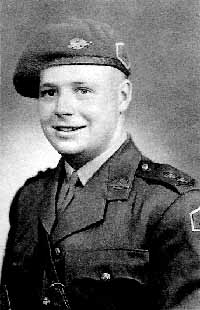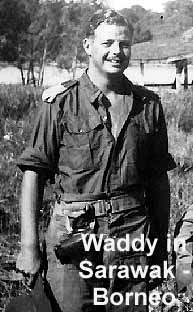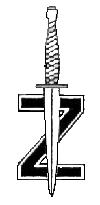Commando Operations in the South China Sea Lt. Rowan E Waddy (21 years) Z Special Unit
Lt. Rowan E Waddy (21 years) Z Special Unit
A commando operations unit, made up primarily of Australian military and called "Z Special Unit", was inserted at times from US Submarines. Such was the case with Operation Crocodile and the 5th patrol of the Hawkbill. Besides the usual assignment of seeking out and sinking enemy shipping, the 5th patrol included inserting Australia commando operatives. In addition to regular boat personnel of 87, this patrol included five commandos, Maj. Bill Jinkins (Party Leader), Capt. Noel Kennard (British Army), Lt. Stan Dodds, Lt. Rowan Waddy and Flt Lt Don Pitt RAAF. Jinkins, Dodds and Waddy were part of Z Special Unit while the other two were assigned from other units for their particular expertise. As you read the "Patrol Reports" located on an adjacent page, you understand the Hawkbill was caught in shallow water by a Kamikaze class destroyer and damaged by severe depth charging. Rowan Waddy, Z Special Unit, writes of this incident . . . "The periscope was left up, fully expecting to see him [destroyer] blow up in our faces. Either the torpedoes underran him or the run was shorter than calculated and the torpedoes were not armed. Because he kept on coming, we could see all hands on the Kamikaze pointing to our scope. The periscope was only half lowered when the Kamikaze roared overhead and let go the works (dropped saturation pattern of depth charges). Hawkbill leaped, shuddered and shook like a thing alive - but she held. Lost all power on everything and out of control, shot to the surface with a 20 degree up angle, exposing sixty feet of the forecastle and putting the bow twenty feet into the air. 'All Back Full' was ordered by the Executive Officer (Lt. Cdr. Fred Tucker) and the CO passed the work to destroy all classified equipment in the ship. The motors were stopped and Hawkbill hit the bottom in eighteen fathoms (thirty-three metres). Kamikaze drew off and commenced a deliberate and systematic search and approach and passed directly over the conning tower many times. Fortunately, the order to destroy did not get through the ship, although all destructors were connected. After three hours of many depth charge explosions, which bounced Hawkbill around the bottom, the Kamikaze finally left the area. There is not any doubt that the Captain of the Kamikaze believed that he had destroyed and sunk Hawkbill with all hands lost. In fact, after the war, [Capt] Scanland met the Japanese Captain, Command Kasuga, Imperial Japanese Navy, who confirmed that he had so reported." After returning to Subic Bay for needed repairs, Hawkbill continued her 5th patrol. It was at this time she received her special assignment to work with the commando party. The commandos carried out native interrogations in the Tambelan Islands and Djemadja Island in the South China Sea learning much of the fortifications of Singapore which proved invaluable in the invasion and recapture of Singapore. In addition, Hawkbill's gunners, using their 5" deck gun, destroyed radio installations before hurriedly departing the area. The Hawkbill moved toward a Japanese Garrison at Terempah Bay. There a well armed raiding party consisting of the Crocodile team and ten American submariners moved cautiously towards the beach. Hawkbill remained on the surface, gun crews ready to give covering fire. After an easy landing, the party moved into and merged with the foliage. Upon searching, they found the village recently deserted. The Japanese had been made aware of the commando presence and rapidly departed not knowing the extent of the raiding party strength or lack thereof. Rowan Waddy related the following incident: "Slightly away from the main batch of huts, I heard a human voice calling, but could not see anyone. After a cautious approach, there was a highly excited very thin dark man clad only in a dirty loin cloth, inside a small wire compound. I threatened to kill him if he did not stop making such loud noises. He knew what I meant by the aggressive thrusts of my submachine gun into his stomach. He said he was a Corporal in the 15th Punjab Regiment and was being held prisoner by the Japanese. Not convinced, I threw him a piece of wood about the size of a .303 rifle, gave him two smart orders: Ahten-shun! and Slo-o-pe arms! His body jerked erect and straight, came smartly to attention, and he brought his 'rifle' to the left shoulder in three precise movements, as it should be done. There was no doubt he had been trained by the British and this automatic reaction saved his life. With a smile, I went to shake his hand but we spontaneously embraced. What a big grin on this thin, happy man, especially when told he could come with us aboard the submarine. He explained why the Japanese and natives had hurriedly fled to the hills. Apparently, as Hawkbill shelled the radio station on Djemadja, the local Japanese commander received a message from that island, indicating a large scale Allied invasion." After destroying a large fuel dump and picking up some souvenirs and while hoisting the US Flag over the garrison, the raiding party heard the ships whistle. A signal to return to the Hawkbill immediately. Capt. Scanland was concerned about sitting in shallow waters knowing that the enemy were aware of his presence. 
"Hawkbill, at maximum knots (approximately 20), cleared the land on each side of the narrow strait and, when in open, deeper water, reduced speed. There were seventeen of us on the outside of the submarine, in and around the conning tower area, when, only twenty minutes after clearing the strait, the stern lookout suddenly sighted three Jakes over Terempah Bay, heading for us, and yelled the alarm: Aircraft approaching - three! The emergency diving klaxon shrieked continuously and seventeen men managed to tumble into and down the conning tower in seconds. Bodies fell on top of bodies, with the ones underneath trying desperately to get out of the way. The conning tower hatch clanged shut and we crash dived. Amazingly, everyone was inside and no one hurt. I must have been very quick because numerous bodies fell on me! When the emergency diving alarm erupts, all hatches must immediately be closed and the submarine crash dives. If anyone is left outside, it is just bad luck. The submarine itself must be protected and has priority over all else." "We submerged quickly and felt the submarine hit the sea bed and there we waited. If the three aircraft had miraculously not sighted us on the surface, then there was every chance that they would see us going down or on the bottom, through the clear tropical water. We waited and waited in deep silence and, with the tension, it seemed like hours, but none of the expected bombs or depth charges eventuated. Finally, the all-clear was sounded and, one and a half hours later, we surfaced and, after a quick searching of the sea and sky, continued the patrol." Captain Scanland later reported: "What guardian angel protects submariners? ... About 1600, acting on one of those odd hunches that saves damn fools like me, I went on deck and sounded the ships whistle, our prearranged signal for the immediate return of the landing force. At 1611, with gear all on deck and being stowed, we started out of the harbour and, by 1620, were clear and ready to dive. At 1640, three Jakes came over the harbour and headed for us. We evaded by submergence and the Grace of God." "We presumed that this station and the Tambelan radio had signaled other Japanese bases and requested warships and aircraft, probably from nearby Malaya or Singapore, to come to their aid. They could cover the two hundred odd kilometres in short time. Hawkbill quickly withdrew and proceeded east on patrol to the Great Natuna Islands." "It was apparently quite clear to both the Japs and the Natives that a major task force was in the process of occupying these islands [Anambas] preparatory to a major push on Singapore." "At least three enemy aircraft were looking for us when we received information (from a Japanese signal from Singapore, intercepted and decoded by special US equipment), that a Japanese Light Cruiser, accompanied by two Escorts, had left Singapore on a specific course to join the hunt for us." "Jinkins had decoded the vital message about the Japanese cruiser and he and Scanland knew that it was chasing us - it doing 21 knots and Hawkbill, on the surface, doing 19 knots. This meant that the cruiser could not get within gun range before we were in our own air cover from Air Vice Marshal Sherger's RAAF Fighter aircraft operating from Labuan. The Japanese broke off the chase after four hours." "It was known that many submarine commanders did not favour being involved with special missions like Crocodile - their understandable reasoning being that these missions reduced the opportunity for them to search and destroy enemy shipping. Also, Special Operations usually involved patrolling in shallow water near enemy-occupied territory, with the submarine committed to waiting nearby and picking up the operatives. This obviously exposes the submarine and crew to additional danger which, in their opinion, is not warranted." "Captain Scanland did not belong to this group; in fact, he welcomed our presence and even asked for more! After agreeing to Jinkins request to pick up twenty additional folboats [small boats resembling kayaks] from Fremantle, Scanland signaled his Admiral:- "We, of course, are happy to do this, (pick up folboats) and perhaps by that time, there will be another special job for us? " His reasoning was that our presence and missions kept the crew keen and greatly lifted the crews morale - they were continuously actively involved instead of just patrolling for days and maybe weeks without seeing anything. Scanland was the type of skipper we wanted and certainly "ships morale is absolutely tops ... and my crew have not had so much fun in months".  Credit for the above information comes, with the author's permission, from
Credit for the above information comes, with the author's permission, from
On Operations With Z Special Unit - WWII by Rowan E. Waddy (Deceased 2000) 1130 Pittwater Road Collaroy, NSW. Australia 2097 |
